 First off, let's get a few things straight. GPS works by using a constellation of about 30 medium earth orbit (MEO) satellites run by the US military which go whizzing around the earth twice every day at a height of 20,000 km to transmit position and time information to receivers on the ground. From this information GPS receivers then can work out where they are. This means that the only person who knows your location is you - there is no path back to the satellite which somehow covertly tells the satellite where you are.
First off, let's get a few things straight. GPS works by using a constellation of about 30 medium earth orbit (MEO) satellites run by the US military which go whizzing around the earth twice every day at a height of 20,000 km to transmit position and time information to receivers on the ground. From this information GPS receivers then can work out where they are. This means that the only person who knows your location is you - there is no path back to the satellite which somehow covertly tells the satellite where you are. Thus GPS devices in themselves can not be used to 'track' the location of users. What they do provide is location information which could then be sent on via some other (radio) connection to enable someones location to be tracked. Standard in-car navigation systems do not have such a facility built in and thus using one does not alert the authorities (or anyone else for that matter) to your location.
That aside, there are in increasing number of uses to which GPS is being put in which the location information it provides is used for control purposes. For example, there are anti-social behaviour tags which monitor the location of offenders and send a signal to the local police or council if the person wearing it goes outside a pre-determined area (or indeed goes inside a particular area).
Similarly, knowing where a vehicle is (for example by sending the GPS location back to a central point via a GSM phone) can be used for road toll or car insurance calculation. There is therefore a growing 'demand' for devices which can stop the GPS receiver working so that the location information for tracking people or cars is not available. Such devices are known as GPS jammers and work in much the same way as the jammers used by various governments to stop international broadcasters.
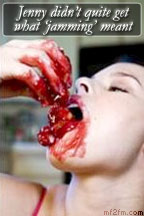 The most basic GPS jammers operate by producing a high power signal on the main frequency used by GPS receivers, strong enough to ensure that the GPS receiver can no longer hear the (very weak) signals from the GPS satellites and therefore thinks it has lost them and stops working. However, receiver manufacturers have gotten wise to such wheezes and have managed to find ways to overcome this 'carrier' jamming. More sophisticated jammers closely mimic the GPS signal so that not only is the receiver overwhelmed by the local interference but it becomes far more difficult to overcome the jamming as it looks just like a valid GPS signal.
The most basic GPS jammers operate by producing a high power signal on the main frequency used by GPS receivers, strong enough to ensure that the GPS receiver can no longer hear the (very weak) signals from the GPS satellites and therefore thinks it has lost them and stops working. However, receiver manufacturers have gotten wise to such wheezes and have managed to find ways to overcome this 'carrier' jamming. More sophisticated jammers closely mimic the GPS signal so that not only is the receiver overwhelmed by the local interference but it becomes far more difficult to overcome the jamming as it looks just like a valid GPS signal.The problem, though, with such jammers is that they don't just wipe out GPS reception by the receiver they are intending to interrupt, but can knock out GPS reception over quite a wide area. Even basic, low power devices (which typically use transmitter powers of around 10 milliWatts) can produce signals strong enough to stop GPS receivers working over a range of several hundred metres. More powerful devices (and there are some easy to get hold of devices which put out a Watt or more) can cause problems for GPS receivers over ranges of over a mile. So without knowing it, someone trying to defeat the GPS monitoring device put in their company car to monitor their movements can unintentionally end up causing aircraft or ships to not be able to identify where they are either.
Now, of course, GPS jammers are illegal to use as they intentionally cause interference which is not just unlawful in that you generally need a licence for any radio transmitter, but that causing harmful interference is a particularly scandalous deed. The problem of GPS jammers is well recognised by the authorities and the impacts of their use so severe that they are one of the very few devices that organisations such as eBay have been asked to stop the selling of on their web-site (try searching there for 'GPS jammer' and you won't find a single one on offer). However, there are ways and means of getting hold of them and like anything that is useful in a 'getting out of paying for something' or 'getting around the law' way, it's almost certain that their sale will continue with devices popping up from new suppliers as the authorities crack down on sellers one by one.
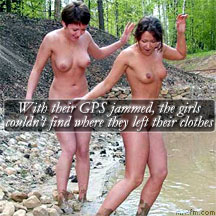 Whilst all this might sound a bit like scaremongering, with aircraft falling out of the sky, that's not the real problem (aircraft don't crash just because they lose their GPS signal). Earlier it was mentioned that GPS satellites transmit both position and time information. The time information is used for a very wide range of applications, from synchronising digital transmitter networks, to ensuring that trades on the stock market are correctly time-stamped. Imagine if these timing signals were lost - TV transmitters would fail and the stock market would come crashing down, so no Coronation Street and no hefty bonuses for city workers (whilst the last of these might not seem too severe, losing Coronation Street would be a national crisis).
Whilst all this might sound a bit like scaremongering, with aircraft falling out of the sky, that's not the real problem (aircraft don't crash just because they lose their GPS signal). Earlier it was mentioned that GPS satellites transmit both position and time information. The time information is used for a very wide range of applications, from synchronising digital transmitter networks, to ensuring that trades on the stock market are correctly time-stamped. Imagine if these timing signals were lost - TV transmitters would fail and the stock market would come crashing down, so no Coronation Street and no hefty bonuses for city workers (whilst the last of these might not seem too severe, losing Coronation Street would be a national crisis). GPS jammers have been described as a 'clear and present danger' and much is being done to try and minimise both their availability and their impact, but it seems their use will continue, and most likely continue to grow. If you feel like popping out and buying one for any reason, think again, you might as well drop a teaspoon of polonium-210 in your local neighbourhood resevoir - the consequences of both for society may not be that far apart!
1 comment
( 1735 views )
| permalink
| 



 ( 2.9 / 71583 )
( 2.9 / 71583 )




 ( 2.9 / 71583 )
( 2.9 / 71583 )
Tuesday 1 December, 2009, 01:21 - Spectrum Management
Posted by Administrator
Some of the biggest brains in Europe, as well as hundreds of millions of Euros of public money are being poured into a concept which has the catchy name of the 'Internet of Things'. The concept in itself is a fairly straightforward one - that as well as people being connected together via the Internet, machines and sensors and all sorts of other electrical and mechanical devices will be connected together as well. So it would be possible for your fridge to talk to your lawnmower, and your kettle to have a chat with your central heating system. Posted by Administrator
Actually, this is nowhere near as silly as it sounds. From the perspective of saving energy and hence carbon, one of the main problems facing electricity generators is dealing with the peak load. In the USA this occurs on the hottest day of the year when air conditioning units are working overtime, and in the UK typically occurs mid-winter when heating units and lots of TVs are turned on, especially during commercial breaks when everyone gets up to make a cup of tea and turns their kettle on. So at these moments, if the kettle could chat with your freezer, for example, and tell it to stop freezing for a few minutes whilst it boils, no-one would be any the wiser and the net result would be a reduction in peak electricity consumption.
This is all fine and dandy and there are plans for 'smart cities' where lots of devices communicate with each other to the benefit of energy consumption, safety and for lots of other good reasons. But there is a limit to how effective such communication can be. Imagine the following discussion:
Kettle to Fridge Please stop freezing for a bit as I need to boil the water to make a cup of tea.
Fridge to Kettle Sorry, no can do. I've already put freezing on hold for a bit to help the tumble dryer out. Perhaps you could speak with it.
Kettle to Tumble Dryer Please could you stop drying for a bit as I need to boil the water to make a cup of tea?
Tumble Dryer to Kettle You must be joking! I've already had to stop 4 times to let the floodlights come on outside and if I don't get these clothes dry soon, there'll be trouble.
Kettle to TV Hey, TV. Any chance you could turn yourself off for a few minutes whilst I boil some water to make a cup of tea?
TV to Fridge Can you believe it? The Kettle has asked ME, ME the TV to turn off so that it can boil some water, who does it think it is?
Fridge to TV I know. Always trying to steal all the power. Nearly as bad as the iron which is on and off like a faulty switch.
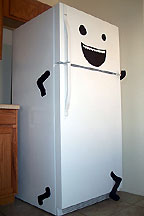 TV to Fridge You are so right. I just pretend Eastenders is on when the iron asks me to turn of, it knows that I couldn't possibly interrupt that programme.
TV to Fridge You are so right. I just pretend Eastenders is on when the iron asks me to turn of, it knows that I couldn't possibly interrupt that programme.Microwave oven to Fridge and TV Can you two pipe down a bit, I'm waiting for an important message from the vacuum cleaner about who is sharing the power tomorrow morning.
And so on...
So there you have it. Several billion Euros of investment brought down by a neurotic TV and an overly chatty fridge. Not to mention the fruit bowl and the salt pot who block the airwaves with their inane chatter about whether sweet or savoury is best. And therein lies the problem: all this communication needs bandwidth, and given the nature of the devices, they will need wireless bandwidth. A European Commission white-paper on the subject addresses the issue several times in statements such as:
[the internet of things] requires truly ubiquitous wireless capacity that can handle several magnitudes more data.
Communication infrastructure should provide ubiquitous connectivity in the presence of significantly increased traffic load and should be very efficient so as to reduce the cost per bit... Many of the local connections are naturally wireless.It goes on to state
Spectrum must be valued: Radio spectrum is one of the most valuable resources of the digital age. As more and more devices and objects become wireless enabled ... spectrum is becoming a key bottleneck. We have to find ways to manage the spectrum more efficiently so as to maximise data throughput and minimise interference.
The report suggests that one possible solution would be to develop a real-time local market in radio spectrum. What does this mean? It means that when you go to make a call from your mobile (or you fridge wants to open a discussion with the vacuum cleaner) it first interrogates the 'spectrum stock market' and chooses the piece of spectrum which offers the right level of connectivity at the appropriate price. Of course the question remains as to how it does this without, in the process, also using a wireless connection.
What is certain, however, is that we have only started to see the beginning of the squeeze on the radio spectrum and that if it seems congested now, compared to the future it is still a wide open space of nothingness. And like oil as it begins to become rare, it is likely we shall see an increase in the value of spectrum too. We here at Wireless Waffle wonder whether there will eventually be unit trusts and other investment wagons on the stock market that invest in spectrum for a profitable return in the same way as they do in gold, silver, oil, crops and other limited resources. If there are, then as prices spiral, it might just shut the fridge up for a bit.
Thursday 24 September, 2009, 14:12 - Spectrum Management
Posted by Administrator
Well who would have thought it! According to many pages on the subject across the internet, hang gliders have a special arrangement with Ofcom to allow them easy access to various radio frequencies without needing a licence! Yes, apparently a chap called Rod Buck, the then radio officer of the British Hang Gliding and Parachute Association (BHPA) reached an 'agreement' with the Radiocommunications Agency some years ago (must have been quite some years as the Agency was disbanded in 2003) that they could use a set of radio frequencies for air to air and air to ground communications and as long as they stuck to them the Agency would 'turn a blind eye'.Posted by Administrator
What are these frequencies? 143.750 to 143.950 MHz in 25 kHz steps. If you don't believe me, take a look here. The top of this frequency range, 143.950 MHz, is the unofficial calling channel and from the Wireless Waffle HQ it is alive most days with chitter chatter from enthusiasts dodging in and out of planes, talking about the weather and checking out possible landing sites.
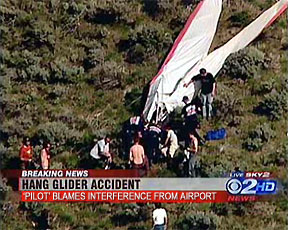 Now it's true to say that the use of radio when airborne presents lots of safety benefits, and it's clear from much of the communication that goes on that the guys dipping and diving around are helping each other out. But there are official frequencies for this purpose. The problem with these official frequencies is that the equipment required to use them is expensive and a licence must be obtained (albeit at just £75 per year), whereas the unofficial frequencies come at no charge and equipment can be had from certain on-line auction sites for less than £50 all sold.
Now it's true to say that the use of radio when airborne presents lots of safety benefits, and it's clear from much of the communication that goes on that the guys dipping and diving around are helping each other out. But there are official frequencies for this purpose. The problem with these official frequencies is that the equipment required to use them is expensive and a licence must be obtained (albeit at just £75 per year), whereas the unofficial frequencies come at no charge and equipment can be had from certain on-line auction sites for less than £50 all sold. Notwithstanding the safety benefits though, the use of these frequencies is, to all intents and purposes, illegal. There is plenty of illegal frequency usage around, from pirate broadcasters to Brazilian satellite hijackers but in all these cases, if the user suffers from interference due to a legitimate user then there is really no harm done as the user's use of radio is not in any way safety related (this is not to say that the legitimate user does not suffer, just that the suffering of the illegitimate user is largely inconsequential). In the case of hang gliders, however, the situation is very different. If they suffer from interference then the implication is that air safety (and possibly even safety of life) is compromised which is quite a big deal when you think about it.
One forum post states:
These frequencies are not currently used or allocated elsewhere, so you won't interfere with anyone else.
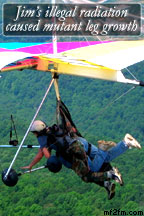 That's not strictly true. The frequencies are actually allocated, in the UK, for 'Land Mobile' services, though at an international (ITU) level they are allocated for Off-Route (eg Military) Aeronautical Mobile use. According to the UK frequency allocation table (FAT) the band 143 to 144 MHz is set-aside for emergency service use. In terms of actual frequencies assignments, it is fair to say that they do seem to be few and far between in this frequency range though there is some evidence to suggest that the US Air Force as well as the Metropolitan Police in London use the frequencies, and that they may well be some of the emptier frequencies being considered to alleviate demand for spectrum during the 2012 London Olympics.
That's not strictly true. The frequencies are actually allocated, in the UK, for 'Land Mobile' services, though at an international (ITU) level they are allocated for Off-Route (eg Military) Aeronautical Mobile use. According to the UK frequency allocation table (FAT) the band 143 to 144 MHz is set-aside for emergency service use. In terms of actual frequencies assignments, it is fair to say that they do seem to be few and far between in this frequency range though there is some evidence to suggest that the US Air Force as well as the Metropolitan Police in London use the frequencies, and that they may well be some of the emptier frequencies being considered to alleviate demand for spectrum during the 2012 London Olympics.Anyway, given the agreement that these users are supposed to have have reached with the regulatory authorities, we here at Wireless Waffle feel that there is plenty of scope to apply the same approach to some other areas of regulation too.
 * Allow electric cars to use either side of the road, as long as they keep their lights turned off and aren't painted a bright colour.
* Allow electric cars to use either side of the road, as long as they keep their lights turned off and aren't painted a bright colour.* Let children cross railway lines (including level crossings) at any time if they are standing near nettles, or being chased by bees, wasps or other stingy things.
* Permit short people to set fire to whatever they like but only if the device used to start the fire can be hidden if anyone approaches.
* Encourage demolition crews to trigger explosions more straightforwardly by simply shining a green torch at the detonator.
* Allow mains wiring in all new houses to be any colour the electricial likes, as long as it fits with the painter's colour scheme.
* Make sure that all knives sold to people weighing under 154 lb (70 kg), of whatever age, are longer than 18 inches and lethally sharp.
* Inform aircraft to keep from crashing into each other by communicating using semaphore and old tin-cans.
Oh, hang on, apparently the Radiocommunications Agency have secretly agreed the last of these with the Civil Aviation Authority. We await the small print of the manifestos of the various political parties at the next election with great interest to see if any other of our other ideas come to fruition or what else the good folk of the UK will be allowed to get away with. Actually, it's pretty clear why aircraft and hang gliders are allowed to act illegaly and not get prosecuted: they are above the law!
Friday 11 September, 2009, 08:08 - Spectrum Management
Posted by Administrator
It seems there is nothing that visitors to the Wireless Waffle web-site like better than a list of interesting radio frequencies to have a go at listening to. Previous articles in subjects such as frequencies for London airports, tuning into US military satellites and unusual UHF activity are some of the more popular pages according to the various logs kept by our web-server.Posted by Administrator
So with that in mind, here are a few 'interesting' HF (short-wave) frequencies that might be worth a listen. Any frequency where recent activity that is most likely caused by the indicated source has been noted (either by Wireless Waffle or on other useful sources) is marked with an asterisk.
Test and Development Frequencies
2806, 5750, 7556, 9071, 10438, 11117, 16014, 18990, 20990, 24135 and 26218 kHz
According to the 2007 UK frequency allocation table (Annex I) these frequencies are the preferred HF frequencies for test and development use (interestingly they have disappeared in the 2008 version. Anyone with a test and development licence is allowed to use powers of up to 100 Watts on these frequencies with a bandwidth of up to 25 kHz. Some years ago, whilst working for a manufacturer of military HF radio equipment, tests of the equipment 'on-air' were witnessed by the Wireless Waffle team using one of the rare 'G9***' UK callsign (the exact call letters of which have been forgotten) and it's fairly certain that these were the frequencies that were used. May be worth a tune around to see what else goes on here.
 Air Cadet Frequencies
Air Cadet Frequencies2368, 2490, 2848.5, 3236*, 3306, 3343, 3678, 3715 and 3752 kHz
(Channel designations Lima 1 through Lima 9 respectively)
5245, 4925 and 5088 kHz
(Channel designations November 1 through November 3)
5770*, 5795, 7740, 6775 and 7721 kHz
(Channel designations Hotel 1 and 2, and 5 through 7)
8120, 13545, 10843.5, 14500, 13445 and 13965 kHz
(Channel designations Oscar 1 through 6)
Air cadets are permitted to use these frequencies with powers of up to 350 Watts (a few are restricted to 100 Watts) for communication. Voice and data can both be used (some channels are data only). Checking a few of the channels revealed occasional strong blasts of data. Note that some of the Lima channels are in the 80 metre amateur band!
 Sea Cadet Frequencies
Sea Cadet Frequencies2122.5, 2695, 3660, 6805, 6875, 6992.5* and 8187.5 kHz
(Channel designations SCO01, 02 and 11 to 15)
Sea cadets are permitted to use between 25 and 100 Watts on these frequencies. Again note the channel (in this case 3660 kHz) in the middle of the 80 meter amateur radio band.
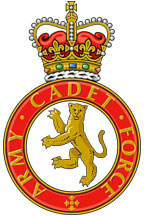 Army Cadet Frequencies
Army Cadet Frequencies2275*, 2415*, 2770*, 3850*, 3865*, 4920, 4922.5*, 4955, 5330, 5345, 6915, 7710 and 7753 kHz
Note that for these frequencies (and those for the other cadet forces), the listed frequencies are supposed to represent the centre of the channel. As such, if listening to an SSB signal, it is necessary to tune 2 kHz lower than the listed frequency. So if you want to listen to 5330 kHz (supposedly a common calling channel for the army cadets, tune initially to 5328 kHz). Also, operation is allowed within 5 kHz of these frequencies so listening plus or minus a bit may yield something interesting.
The sea cadet and RAF cadet frequencies are taken from official publications, whereas the army cadet frequencies are based on an extensive search and cross-check of internet sources but these may not be as accurate as the earlier two!
 RAF Flight Watch (TASCOMM)
RAF Flight Watch (TASCOMM)4742*, 5702*, 9031*, 11247, 13257 and 18018 kHz
TASCOMM is part of the Defence High Frequency Communication Service (DHFCS) which is managed from the network control centre at Forest Moor. They are the frequencies used by the RAF. DHFCS also managed the HF frequencies for the Army and Navy too. Transmitters are often high power and are located both in the UK and at some overseas military bases (such as Cyprus and Ascension). The net controller uses the callsign 'XSS'.
Note that those frequencies market with an asterisk (*) are ones on which either activity has recently (ie in the past 5 years) been reported somewhere on-line, or where the Wireless Waffle receiver has noted activity.
Now it would be good to try and make something of this list and identify lots of 'secret military HF bands' where there were hotspots of activity, however no such hotspots really emerge, instead there are a few warm damp patches which might be worth exploring. Where there is any commonality between these frequencies it is in the ranges {the ITU allocation to these bands is shown in curly brackets}:
- 3660 - 3865 kHz (6 assignments) {Mobile/Land Mobile};
- 4742 - 5088 kHz (6 assignments) {Mobile/Land Mobile/Aeronautical Mobile (OR)};
- 5702 - 5795 kHz (4 assignments) {Land Mobile/Aeronautical Mobile (OR)};
- 6775 - 6992.5 kHz (5 assignments) {Mobile};
- 7556 - 7753 kHz (5 assignments) {Mobile};
- 8120 - 8187.5 kHz (2 assignments which is not exactly conclusive) {Maritime Mobile}; and
- 9031 - 9071 kHz (again 2 assignments) {Aeronautical Mobile/Fixed}.
 In almost all of these cases, the frequencies concerned fall within the 'Mobile', 'Land Mobile', in the case of TASCOMM, in the 'Aeronautical mobile (OR)' and in the case of the Sea Cadets the 'Maritime Mobile' services of the ITU and as such are almost exactly where you would expect to find them had you decided to look there in the first place. The only oddity is the test and development frequency at 9071 kHz which is in a 'Fixed' band, but then again, this is not a military frequency and it's quite possible that someone somewhere might want to test an HF fixed link.
In almost all of these cases, the frequencies concerned fall within the 'Mobile', 'Land Mobile', in the case of TASCOMM, in the 'Aeronautical mobile (OR)' and in the case of the Sea Cadets the 'Maritime Mobile' services of the ITU and as such are almost exactly where you would expect to find them had you decided to look there in the first place. The only oddity is the test and development frequency at 9071 kHz which is in a 'Fixed' band, but then again, this is not a military frequency and it's quite possible that someone somewhere might want to test an HF fixed link.So, sadly, no secret service special frequency bands have been identified but at least it seems that the United Kingdom's armed forces are doing their bit to uphold the sanctity of the ITU frequency allocation table.

